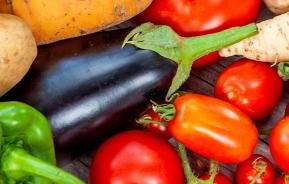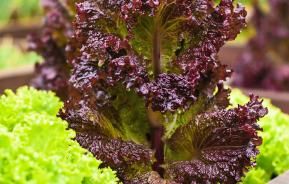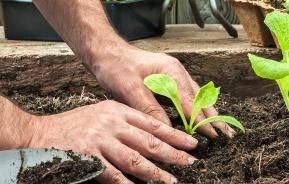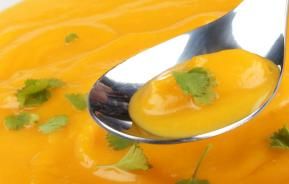Although they are both called artichokes, Jerusalem and globe artichokes are completely different – both in how they grow and how they’re used in the kitchen. But both are perennial plants, easy to grow – and delicious to eat.
The globe artichoke is a variety of thistle, a large, architectural perennial that looks great when grown in flower beds and borders. The edible parts are the fleshy lower portions of the bracts of the unopened flower buds and their base, known as the ‘heart’. Once the flower buds open, the flowers look beautiful and very attractive, but are inedible. The plants have very ornamental, large, silvery-green/glaucous-green leaves.The Jerusalem artichoke is a species of sunflower, grown for its edible tubers. These are a real winter treat, although an acquired taste for some. You can roast them, make them into chips and fry them, and they make a hearty soup. They are easy to grow, even in poor soils. In the summer, they produce lots of reasonably small sunflower-like flowers. As the plants grow tall (up to 3m/10ft), they can be used as a living screen.
How to grow artichokes
Cultivating artichokes
Globe artichokes
Globe artichokes prefer an open position in full sun. They need a reasonably fertile, well-drained soil. They are fairly drought resistant once established.
Jerusalem artichokes
Jerusalem artichokes will thrive in sunny or shady positions. They will grow well in even poor soil, but produce larger yields if the soil is well prepared with lots of added bulky organic matter first.
Varieties of artichokes
Globe artichokes
- Gros Vert de Laon: Produces the largest hearts.
- Green Globe: Large green heads. May need winter protection.
- Purple de Provence Purple: flower buds, early cropping.
- Purple Sicilian: Small, deep purple flower buds.
Jerusalem artichokes
- Common: Very knobbly tubers.
- Fuseau: A smooth-skinned variety, that is easy to peel.
- Gerrard: Colourful red skin, white flesh with a smoky flavour.
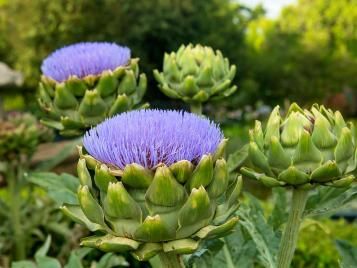
Sowing globe artichokes
For best results when growing artichokes from seed, sow in March and April in pots or trays of moist seed sowing compost at a temperature of 15-20°C (65-70°F).
Transplant seedlings when large enough to handle into 7.5-10cm (3-4in) pots and grow on in a warm, light position. Harden off by growing on in cooler conditions for 10-15 days before planting out after all risk of frost, 60-90cm (2-3ft) apart.
You can also direct sow globe artichoke seed outdoors from March to April when the soil has warmed up. Sow in a well-prepared seedbed, placing 2-3 seeds at stations 30cm (12in) apart. When large enough to handle, thin out the seedlings to 1 per station and then finally 60cm (2ft) apart.
Planting artichokes
Globe artichokes
Plant out young plants, preferably in spring, 60-90cm (2-3ft) apart.
Dig over the planting area, incorporating lots of organic matter – such as compost or planting compost, especially if the soil is heavy clay or light, well-drained sandy soil. Dig a good sized hole big enough to easily accommodate the rootball.
Place the rootball in the planting hole and adjust the planting depth so that the crown of leaves is at soil level.
Mix in more organic matter with the excavated soil and fill in the planting hole. Apply a general granular plant food over the soil around the plants and water in well.
Then add a 5-7.5cm (2-3in) thick mulch of organic matter over the soil around the plants.
Jerusalem artichokes
Plant small tubers in March or April in well-prepared soil, 10-15cm (4-6in) deep and 30cm (1ft)) apart with rows 90cm (3ft) apart. Large tubers can be cut into sections, providing each one has 2 or 3 buds. Apply a little general granular plant food over the soil.
Tubers can also be grown in large pots filled with a good potting compost.
How to care for artichokes
Globe artichokes
Although reasonably drought resistant, you may need to water during prolonged periods of dry weather, especially when the flower buds are forming.
Feeding with a general granular plant food each spring will increase yields.
Keep plants weed-free and mulch with well-rotted manure or compost in spring. In cold areas, you may need to cover plants with a mulch of straw, compost or similar in late autumn to protect them from cold winter weather.
Divide plants every 3 to 4 years to keep the plants young, vigorous and cropping well.
Jerusalem artichokes
Jerusalem artichokes are easy to grow. Once planted and growing well, they rarely need any supplementary watering or feeding. Only water during periods of severe drought.
Weeding shouldn’t be necessary, as plants produce a dense, weed-suppressing canopy of foliage.
In exposed areas, when the stems reach 30cm (12in) high, pile up earth around them to a depth of 15cm (6in) to make the plants more stable.
When the foliage starts to turn yellow in autumn, cut down the stems to 7.5cm (3in) above ground level.
Harvesting artichokes
Globe artichokes
Cut off the flower buds, ideally when they reach the size of a golf ball, with a pair of secateurs, before they open and start to flower. After harvesting the main head, secondary usually smaller heads appear on sideshoots, which can be harvested later.
Jerusalem artichokes
Harvest as needed from October/November to February, carefully lifting the tubers with a garden fork. They will survive all but the harshest winters, so can be left in the ground, although slugs and waterlogging can be a problem.
The roots store well, providing a valuable food source throughout winter.
Some people leave the tubers in the ground, just harvesting as needed, and allowing the remainder to grow on to crop the following year. Their quality does degrade unless the plants are dug up and replanted in fertile soil.
| Flowering season(s) | Summer |
|---|---|
| Foliage season(s) | Spring, Summer, Autumn |
| Sunlight | Full sun |
| Soil type | Chalky, Clay, Loamy, Sandy |
| Soil pH | Neutral |
| Soil moisture | Moist but well-drained, Poorly drained |
| Ultimate height | Globe artichoke: up to 1.5m (5ft); Jerusalem artichoke: up to 3m (10ft) |
| Ultimate spread | Globe artichoke: up to 1.2m (4ft); Jerusalem artichoke: up to 60cm (2ft) |
| Time to ultimate height | 5-6 months |





